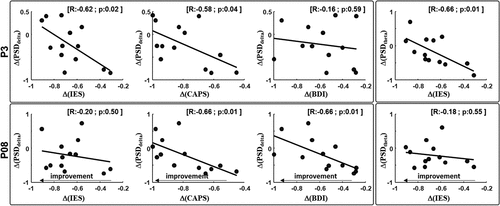Figures & data
Table 1. Demographic data of participants at baseline.
Table 2. Comparison of clinical variables for the two groups (EMDR and TAU).
Table 3. Comparison between T0 and T1 of clinical variables for the two groups (EMDR and TAU).
Table 4. Multivariable linear regression models for each clinical score at T1. β values regard the effect of receiving EMDR (vs. TAU).
Figure 1. T0 vs. T1 power spectral density analysis (PSD).

Figure 2. T0 vs. T1 EMDR PSD difference localization analysis.

Figure 3. Correlation analysis.

